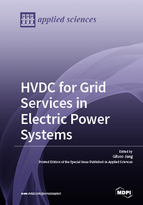HVDC for Grid Services in Electric Power Systems
A special issue of Applied Sciences (ISSN 2076-3417). This special issue belongs to the section "Energy Science and Technology".
Deadline for manuscript submissions: closed (25 September 2019) | Viewed by 38064
Special Issue Editor
Interests: HVDC control; transient stability; HVDC system planning
Special Issues, Collections and Topics in MDPI journals
Special Issue Information
Dear Colleagues,
We are inviting submissions of original research to a Special Issue of Applied Sciences on the subject of “HVDC for Grid Services in Electric Power Systems”.
The modern electric power system has evolved into a huge nonlinear complex system, due to the interconnection of thousands of generation and transmission systems. The unparalleled growth of renewable energy resources (RES) has caused significant concern regarding grid stability and power quality, and it is essential to find ways to control such a massive system for effective operation. The controllability of HVDC and FACTs devices allows for improvement of the dynamic behavior of grids and their flexibility. Research is being carried out at both the system and component levels of modelling, control, and stability. This Special Issue aims to present novel topologies or operation strategies to prevent abnormal grid conditions.
Prof. Dr. Gilsoo Jang
Guest Editor
Manuscript Submission Information
Manuscripts should be submitted online at www.mdpi.com by registering and logging in to this website. Once you are registered, click here to go to the submission form. Manuscripts can be submitted until the deadline. All submissions that pass pre-check are peer-reviewed. Accepted papers will be published continuously in the journal (as soon as accepted) and will be listed together on the special issue website. Research articles, review articles as well as short communications are invited. For planned papers, a title and short abstract (about 100 words) can be sent to the Editorial Office for announcement on this website.
Submitted manuscripts should not have been published previously, nor be under consideration for publication elsewhere (except conference proceedings papers). All manuscripts are thoroughly refereed through a single-blind peer-review process. A guide for authors and other relevant information for submission of manuscripts is available on the Instructions for Authors page. Applied Sciences is an international peer-reviewed open access semimonthly journal published by MDPI.
Please visit the Instructions for Authors page before submitting a manuscript. The Article Processing Charge (APC) for publication in this open access journal is 2400 CHF (Swiss Francs). Submitted papers should be well formatted and use good English. Authors may use MDPI's English editing service prior to publication or during author revisions.
Keywords
- Control, operation and planning of HVDC Systems
- Active control of HVDC systems
- HVDC control for special protection systems
- HVDC operation scheme for stability improvement
- Intelligent strategies for HVDC voltage support
- New control techniques in HVDC
- New HVDC applications
- HVDC protection schemes






